- Search efforts for missing pilot suspended in Pacific
- Navy official says two F/A-18 Hornets collided
- The cause of the crash is under investigation, Navy says
(CNN) -- The Navy has suspended search and rescue efforts for a pilot who was involved in a plane crash over the western Pacific Ocean.
Two U.S. fighter jets collided on Thursday while operating at sea.
The missing and unidentified pilot is presumed dead, the Navy said in a press release on Saturday. One pilot was rescued, treated and has been released from the ship's medical facilities.
"This is an exceptionally difficult time for the friends and family of the missing pilot and the Navy community," said Rear Adm. Christopher Grady, commander of the Carl Vinson Carrier Strike Group. "Our thoughts and prayers are with everyone affected by this tragedy."
The cause of the crash is under investigation, the Navy said. The jets have not been recovered.

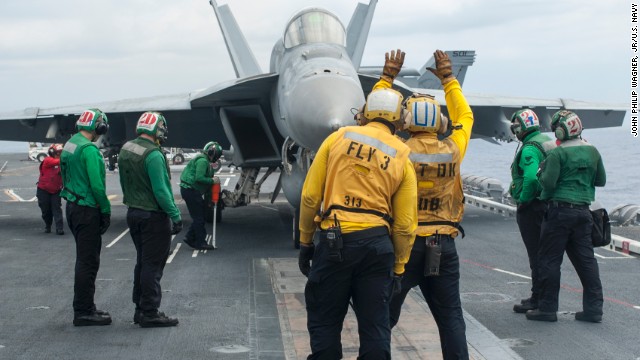 An F/A-18E Super Hornet from the Sunliners of Strike Fighter Squadron 81 taxis onto a catapult prior to launching from the flight deck of the aircraft carrier USS Carl Vinson. Two F/A-18s flying from the carrier crashed into the Pacific Ocean, the Navy said on Friday, September 12.
An F/A-18E Super Hornet from the Sunliners of Strike Fighter Squadron 81 taxis onto a catapult prior to launching from the flight deck of the aircraft carrier USS Carl Vinson. Two F/A-18s flying from the carrier crashed into the Pacific Ocean, the Navy said on Friday, September 12.  An F/A-18 Hornet is pictured aboard the USS George H.W. Bush on May 19, 2009. Two F/A-18s from the Bush struck ISIS artillery in Iraq on Friday, August 8. The F/A-18 Hornet, a late-'70s contemporary of the Air Force's F-16 Fighting Falcon, became the workhorse of U.S. carrier-based air power, and still supplements the Navy's and Marines' more current fleet of F/A-18E and F/A-18F Super Hornets. It is designed as both a fighter and attack aircraft.
An F/A-18 Hornet is pictured aboard the USS George H.W. Bush on May 19, 2009. Two F/A-18s from the Bush struck ISIS artillery in Iraq on Friday, August 8. The F/A-18 Hornet, a late-'70s contemporary of the Air Force's F-16 Fighting Falcon, became the workhorse of U.S. carrier-based air power, and still supplements the Navy's and Marines' more current fleet of F/A-18E and F/A-18F Super Hornets. It is designed as both a fighter and attack aircraft. 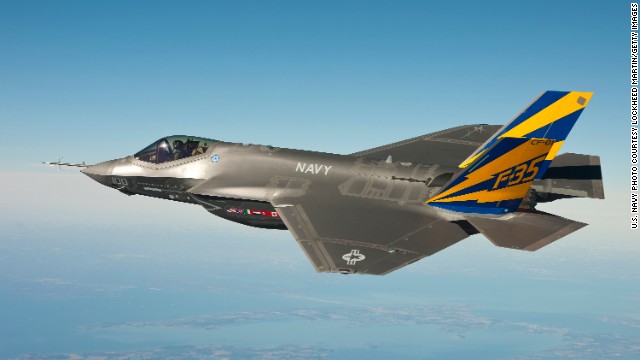 A F-35C conducts a test flight over the Chesapeake Bay on February 11, 2011. Inspections of F-35 engines have been ordered after a runway fire took place at Eglin Air Force Base on June 23. The F-35 Lightning II, still in its development and testing phase, has been beset by delays and cost overruns in the years since its introduction.
A F-35C conducts a test flight over the Chesapeake Bay on February 11, 2011. Inspections of F-35 engines have been ordered after a runway fire took place at Eglin Air Force Base on June 23. The F-35 Lightning II, still in its development and testing phase, has been beset by delays and cost overruns in the years since its introduction.  F-16 Fighting Falcons are parked at the Aerospace Maintenance and Regeneration Center in Tucson, Arizona, on December 11, 2004. General Dynamics (which was later sold to Lockheed) delivered the U.S. Air Force its first F-16As in 1979. More than 4,500 of the fighters have been built and are used by more than 20 nations in addition to the United States.
F-16 Fighting Falcons are parked at the Aerospace Maintenance and Regeneration Center in Tucson, Arizona, on December 11, 2004. General Dynamics (which was later sold to Lockheed) delivered the U.S. Air Force its first F-16As in 1979. More than 4,500 of the fighters have been built and are used by more than 20 nations in addition to the United States. 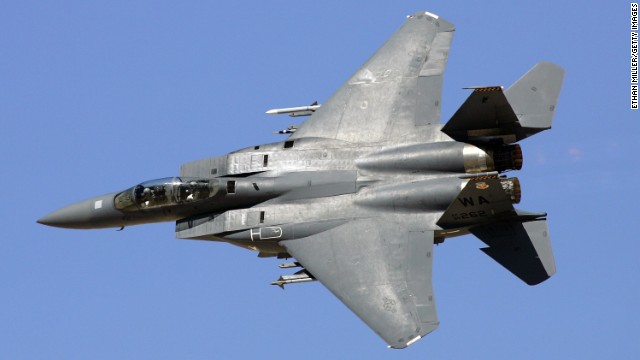 An F-15E Strike Eagle flies by during a U.S. Air Force demonstration on September 14, 2007, near Indian Springs, Nevada. The F-15E was designed for long-range, high-speed interdiction without relying on escort or electronic warfare aircraft. It was derived from the F-15 Eagle, which was developed to enhance U.S. air superiority during the Vietnam War.
An F-15E Strike Eagle flies by during a U.S. Air Force demonstration on September 14, 2007, near Indian Springs, Nevada. The F-15E was designed for long-range, high-speed interdiction without relying on escort or electronic warfare aircraft. It was derived from the F-15 Eagle, which was developed to enhance U.S. air superiority during the Vietnam War. 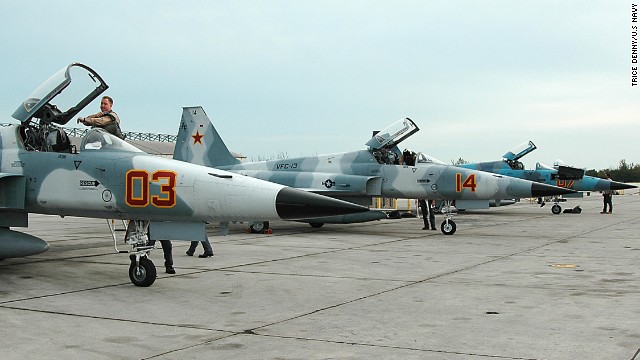 Pilots perform daily flight checks on their F-5E/F Tiger aircraft in Key West, Florida, on January 7, 2005. The Vietnam-era aircraft -- one of several offshoots of the original Northrup F-5s that went into service in the early 1960s -- is used to simulate adversary aircraft in training.
Pilots perform daily flight checks on their F-5E/F Tiger aircraft in Key West, Florida, on January 7, 2005. The Vietnam-era aircraft -- one of several offshoots of the original Northrup F-5s that went into service in the early 1960s -- is used to simulate adversary aircraft in training. 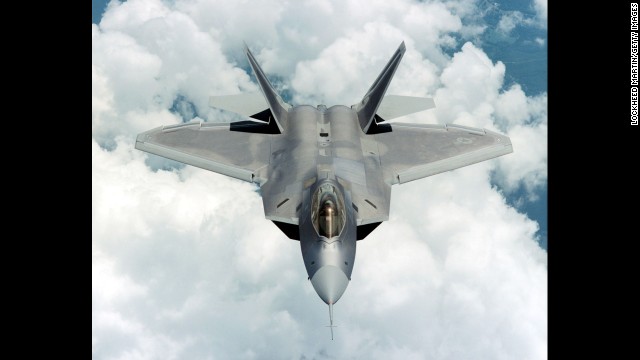 A F-22 Raptor flies over Marietta, Georgia, home of the Lockheed Martin plant where it was built. The F-22 is the only fighter capable of simultaneously conducting air-to-air and air-to-ground combat missions.
A F-22 Raptor flies over Marietta, Georgia, home of the Lockheed Martin plant where it was built. The F-22 is the only fighter capable of simultaneously conducting air-to-air and air-to-ground combat missions. 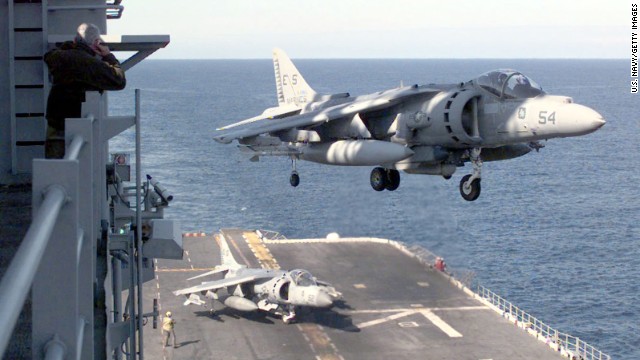 A AV-8B Harrier lands on board the USS Nassau on April 14, 1999, following a strike mission into Kosovo. The AV-8B Harrier is a single-engine ground-attack aircraft capable of vertical or short takeoff and landing. Though production of the aircraft ceased in 2003, the U.S. Marine Corps is looking at systems enhancements and plans to continue using Harriers well into the next decade.
A AV-8B Harrier lands on board the USS Nassau on April 14, 1999, following a strike mission into Kosovo. The AV-8B Harrier is a single-engine ground-attack aircraft capable of vertical or short takeoff and landing. Though production of the aircraft ceased in 2003, the U.S. Marine Corps is looking at systems enhancements and plans to continue using Harriers well into the next decade. U.S. military's fighter fleet
U.S. military's fighter fleet
U.S. military's fighter fleet
U.S. military's fighter fleet
U.S. military's fighter fleet
U.S. military's fighter fleet
U.S. military's fighter fleet
U.S. military's fighter fleet
 U.S. military's fighter fleet
U.S. military's fighter fleet The two jets crashed about 290 miles (470 kilometers) west of Wake Island, Navy 7th Fleet spokeswoman Lt. Lauren Cole told CNN. Wake Island is more than 2,400 miles west of Hawaii.
A Navy cruiser, destroyer, carrier and helicopters took part in what the Navy called an "extensive" search for the missing pilot that lasted more than 36 hours.
The two F/A-18 Hornets were operating from the aircraft carrier USS Carl Vinson, the Navy said. The collision occurred about seven miles away, the Navy said.
Both jets are from Carrier Air Wing 17, the Navy said, assigned to Strike Fighter Squadron 94 and Strike Fighter Squadron 113.
Pilot found dead after F-15 crash in Virginia
CNN's Jamie Crawford contributed to this report.
No comments:
Post a Comment